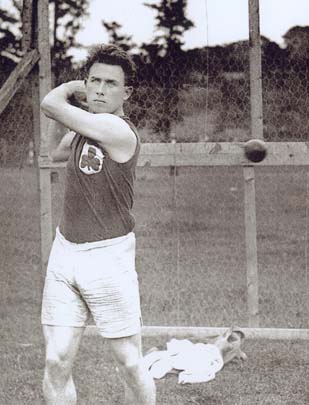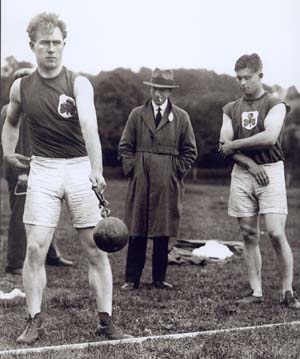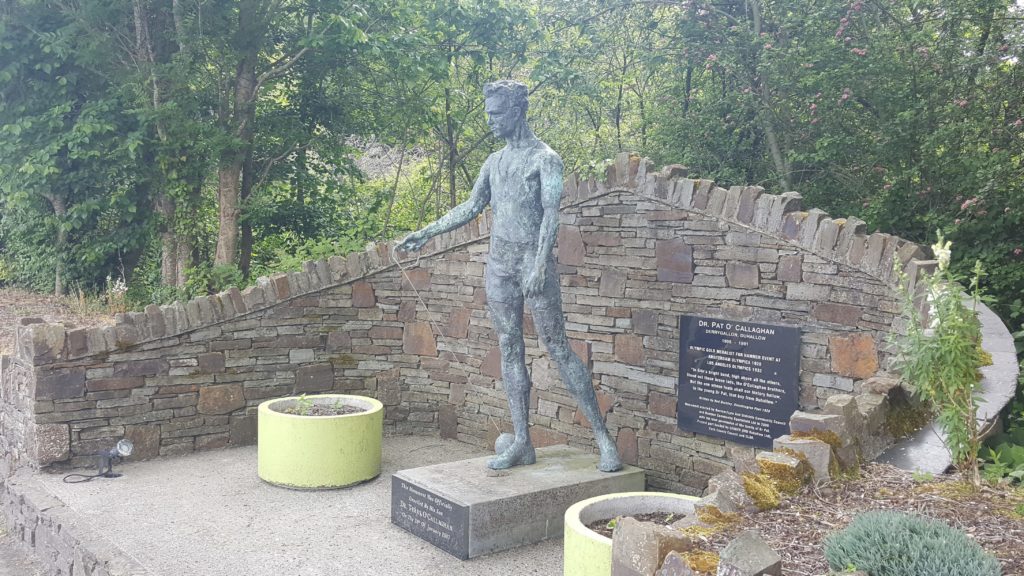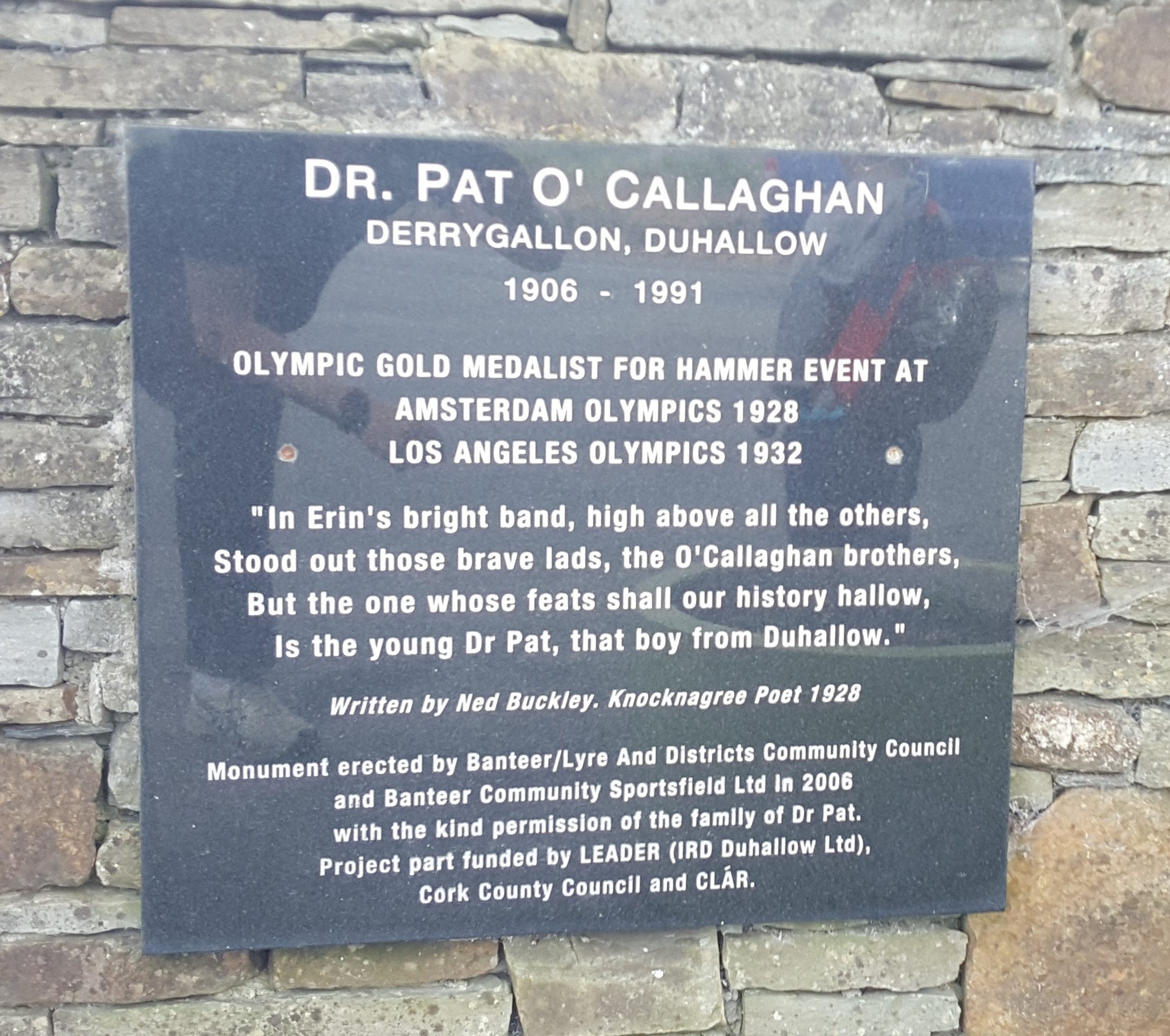
Doctor Pat as he was affectionately known in his native Duhallow, was born on the 28th of January 1907 at Derrygallon, 3 miles south west of Kanturk town. Pat was the third and youngest son of Paddy O’Callaghan and Jane Healy.
Doctor Pat’s mother was Jane Healy, eldest daughter of John Healy and Julia Vaughan of Cloonteens, Castlemagner. Her brother Tim was a National Sprint champion and played on the 1893 Cork/Dromtariffe football team. Jane was of average height and build with a quiet competent manner. A qualified Nurse, she was also Midwife for the district. She ran the family with a firm hand and was a resolute damper on the wild and vigorous nature of her boys. Her priority was their education and she tolerated their sporting activity only in so far as it did not interfere with study. A quiet maternal pride was evident only in her glittering Trophy Room where their cups, medals and other prizes were on show for very special visitors.
Her eldest son Sean was known locally as Jack Lissie in accordance with the tradition in the family. He took after his mother’s people and had a blockier build than the other two. He was a hardy boy on and off the football field and a fine athlete whose successes included a National 440yards Hurdles title. On leaving school, he was kept at home and in due course he inherited the family farm. He also inherited his father’s flair for salmon-poaching and lost three fingers of his right hand when dynamiting a kill hole in the Arrigle river.
The middle son Con was the lightest of the three and experts rated him the best one of the Callaghans . After college he served in the Garda Siochana before purchasing the Bantry Bay Hotel in Bantry. He was a natural athlete and excelled as a runner, jumper and thrower. A renowned Decathlete, in his career he won championships embracing almost every discipline.
Pat, the youngest son, was the tallest and heaviest of the brothers. He was a precocious child and entered Derrygallon National School at the infant age of 2 years and 4 months. His passions were hunting, poaching and playing football in nearby Cronin’s Field.
The spell of athletics was cast for him by the exploits of the colourful Denis Horgan at Banteer Open Sports. Pat progressed to secondary school in Kanturk and at the age of 15 won a scholarship to the famed Patrician Academy in Mallow. He matriculated and passed the entrance examination for the Royal College of Surgeons when just over 16 years old. During his year in the Academy he daily cycled the 32-mile round trip from Derrygallon and never missed a class. A brilliant scholar, he also represented the Academy in Colleges sports.

In the red Banteer AC vest he was a feared and popular competitor in local Parish Sports and in Open Sports within a bicycle-range 30 mile radius. He selected his events according to the value of the prizes, taking account of the ever-vigilant handicappers and the designs of the opposition. Local opposition was strong – siblings Jack and Con, the Guiney brothers of Kanturk, John Joe Horgan of Pallas (Castlemagner) and Connie Sullivan of Cloonteens (a future National High Jump champion), were always lurking for a kill. The cut-glass tableware, teapots and household items that Pat won were usually sold on the way home to pay for books, fees and other expenses.
From an early age he made friendships with his mother’s relatives in and around Castlemagner that he was to cherish all his life. The family farm of her cousin Lizzie Donoghue nee Healy in Knockardsharrive was a favourite hit for holidays that offered a heady mixture of sport, farm-work and youthful companionship. His other close associates were the Ludgates from nearby Rathnee, keen weight-throwers of national championship standing.
He was a legendary centre-forward and midfielder on the Dromtariffe Football team- displaying his father’s qualities of great passion and physical presence on the field. He also played at full-forward on the Castlemagner hurling team. In an incident in a football match in Cronin’s Field in Derrygallon he shouldered an aggressive opponent so hard that the airborne recipient crushed a pram parked well beyond the sideline. Luckily, the pram was unoccupied at the time. The local PP scolded Pat for a disgrace to the parish and chased him off the field with an umbrella.

In Dublin, lectures and study were always the first priority for Pat. But ever open to new experiences, he got involved in all types of sport including Senior club Rugby. Among his incognito exploits with the oval ball was a penalty converted from 75 yards.
At the old UCD sportsground in Terenure he got a first taste of Hammer-throwing and developed an immediate interest in the event. While training for the University Boxing championships at the Garda gym in the Coombe, he fell in with Superintendent Dinny Carey, trainer of the Garda team. Dinny was from Kilfinnane and introduced Pat to a golden circle of friends. Tipperary Garda Ned Tobin was a National 56lb Without-Follow champion and later the national record holder, whom Pat frequently met in competition.
Paddy Ryan, a farmer in Pallasgreen, was the World record holder for the Hammer. The family were involved in the poultry business and had the nickname Chicken to distinguish them from the many other Ryans in the locality. He threw for USA at Antwerp in 1920, winning a Gold in the Hammer with 173′ 4″ and a Silver in the 56lb DWF with 35′ 11″ before returning to Ireland at the age of 45.
John Flanagan from Kilmallock, in his prime the leading all-round athlete in the world, was another friend. At one time he held World records in seven events. Before 1900, under the rules of the lethal Unlimited Run and Follow he moved the Hammer record 14 times to over 185 feet. Tom Barry of Castlemagner, a contemporary county sprinter, described him Flanagan “six foot and fourteen and a half stone & the ground shaking under him people stopped to look at him & Holy Jee he was like a tiger ! I threw him a banana to keep him quiet !” . Exceptionally fast, John Flanagan was the first to win an Olympic Hammer title from a 7 circle and had won 3 Olympic Gold Medals for USA by 1908. He had also a Silver for the 56lb DWF with a cast of 33 4 at Missouri in 1904. In 1909 he introduced a 3rd turn to the hammer-throw and set a World record at 173′ 3″.

Dinny Carey’s golden circle also included Matt McGrath, a Nenagh farmer and winner of the Gold medal at Stockholm in 1912 with a throw of 179′ 7″. He took his third Olympic medal for the USA with a Silver at Paris in 1924 at the age of 47.
In the fine summer of 1926 Pat arrived in Knockardsharrive with a plan of campaign to master the Hammer. Aided by local enthusiasts he manufactured a hammer by boring a 1″ hole through a 16lb Shot and filling it with the ballbearing-ed core of a bicycle pedal to release torque from the rigid bar-wire handle. The core was secured in lead which also provided for adjustment of the weight.
He set out a throwing circle in the Front Field and with the determination and total concentration that was his trademark, he worked-up his new technique. It was an exhilarating time for all concerned as the assembly came in for rough handling, frequently breaking to threaten nearby life and limb and involving many tedious searches in heavy summer undergrowth for the elusive ball.
The training was regularly interrupted for farm work interspersed with impromptu cross-country races, fiercely contested over hedges and 5-bar gates for the exhilaration of competition. When he introduced quantities of raw eggs and bloody raw steak to his diet, the charm of his deep blue eyes and shock of fair hair was not enough to offset the disgust of the women of the household. Pat also travelled to Limerick to work with Paddy ‘Chicken’ Ryan whose 1913 World Record of 189′ 6″ he would later exceed but which officially was to stand for 25 years until broken by Ernst Blask of Germany with a throw of 193′ 6″ in 1938.
Returning to Dublin, Pat came to prominence on the national athletics scene when he won the Hammer championship of 1927 with a modest throw of 142′ 3″ . At that time premier national athletics events took place in June/July in the Phoenix Park – the Garda Sports, the National Championships and the quatrenniel Tailteann Games. Cork City had the best track and field arena in the country and hosted the popular Cork City Drapers Sports and international athletics matches. Premier meetings were attended by all the top athletes and by huge partisan crowds of 10,000 and more, wildly encouraging their heroes of parish and county.
In those cauldrons of competition, the throwing surface was often wet and yielding and the win was more important than distance achieved. In 1928 Pat retained his National title with a throw of 162′ 6″ and qualified for the Olympics. His brother Con won the Shot Putt and the Decathlon the same day and also qualified for the Olympics in the Decathlon. Pat went on to improve on his mark at the RUC Sports in Belfast and at an Invitation match at Athlone where he threw 166′ 11″. He competed in two International matches, on both occasions finishing behind Malcolm C Nokes, darling of the British Press and the leading thrower in Europe at the time.
Pat had graduated as a Surgeon Doctor before his 21st birthday and was finishing post-graduate studies. The evolution of his new hammer throwing technique challenged the convention that hammer-throwers were huge men of towering stature. The older Irish Whales powered the throw with immense body strength, completing one or two turns in two-footed hops. They anchored the throw with body weight and released the ball at shoulder level with arms bent.
At 5 ’11” , Pat was short by conventional standards though his big-boned well-proportioned frame made him look smaller than he actually was. His main focus was on the principles of Physics laid out by Dinny Carey – that power is lost when contact with the ground is broken and that the faster the speed of the ball at release, the further the throw. He emulated the fast action of John Flanagan and the controlled accelerating wind-up used by Paddy Ryan – both men were, like himself, relatively short of the conventional stature. He also perused articles and publications by academicians and technical experts in Europe who were pioneering the application of scientific principles to Hammer throwing and other sports. In Dublin he came under the influence of John Tallon a mysterious tailor who made a private study of the theory of hammer-throwing. Tallon later coached the Mayoman Bert Healon, a top thrower of the 1940s, as well as Doctor John Lawlor who threw 213′ 0″ for fourth place in the 1960 Rome Olympics.
By mid-1928, Pat had more or less perfected his technique. From a relaxed slow start he smoothly moved into a fast accelerating rotation through three turns keeping ahead of the weight and pulling down on the wire in the downward arcs. The 1-ton centrifugal pull was taken by his powerful legs alternately on heel and toeball, with a pronounced lean-back of upper body and head, the action sweeping upward to a high straight-armed position where he gathered himself for release in a high 45° delivery. This still remains the classic style in modern Hammer-throwing. The spectacular increase in distances achieved after 1950, sprang more from improvements in the throwing surface, from advances in equipment design and materials and from increased turning speed acquired through scientifically tailored weight-training regimes, than from any advancement on Pat’s original technique.
In the summer of 1928 Pat and Con, with their brother Jack paid their own way to the Games in Amsterdam. Con’s progress in the Decathlon was halted by a Games romance and he recorded a Did Not Finish . Pat was still a relatively untried novice at international level and was not expected to get beyond the preliminary stage. However, he got through in 6th place and started the Final with a throw of 155′ 9″ to lie 3rd and almost 13ft behind the polished Swede Oissian Skoeld – but ahead of the favourite Malcolm Nokes of Britain. A master of the psychological games of competition, Pat made his second throw using the Swede’s own finely-machined hammer. The ball soared out to 168′ 7″ to beat the Swede by 4′ . It won a 1st Olympic Gold Medal for Pat and for his newly independent country.
The result was reported with less than warmth by the jingoistic British Press; the podium presentation also featured the Irish Tricolour and the playing of Amhrain na bFiann – both of which were still illegal emblems of subversion under British law. Pat came home to a tumultuous welcome in Kanturk but there was no State or civic recognition. He went on to attend sports meetings and social events around the country as a guest of honour. His warmth of personality and unequivocal love of all things Irish endeared him to people every where he went. Shortly afterwards he secured an appointment as a Surgeon Doctor in Clonmel Mental Hospital and he later settled in that area when he married Miss Kitty O’Reilly of Clonmel and Kilmallock, a lady who was a popular leading connection in the greyhound business in her own right.
Through 1929 – 1932 Doctor Pat’s performances peaked at a level never achieved by any other athlete since or before. In the national championships of 1930 he won the Hammer, Shot, 56lbs Without-Follow, 56lb Over-the-Bar, Discus and High Jump. He also regularly represented Ireland in international matches in a variety of events. His performance in each was to a high international standard.
He won 3 National titles in High Jump, clearing over 6 foot on each occasion, with a personal best of 6′ 2″ . At Cork in 1930, from a grass track and a shallow pit fit only for a braced two-footed landing, he tucked his great knees under his chin and hurled his 16-stone over the bar set at 6′ 4″ – a mere handbreadth below the World record. The jump was wrongly disallowed as it was adjudged to have breached the then obsolete foot first rule. He regularly cleared 22 feet in Long Jump and putt the Shot over 49 foot -well up to Olympic qualifying standards. His winning Discus throw at the 1931 championships was 152′ 7″ – a fraction of an inch short of the European record.
In the summer of 1930 he took part in a 2-day Invitation event in Stockholm where Oissian Skoeld was confidently expected to prove that the Irishman had caught him on an off day at Amsterdam. Throwers from Britain, Germany, Norway, Denmark, Finland and Japan also took part. In the first-day competition, Skoeld, doyen of a great school of Swedish throwers, was on form and broke his own European record with his very first throw to take the lead. Undaunted, Pat overtook him with his second throw, breaking the new record and once again beating the local star into second place. On the second day Pat and Skoeld were neck-and-neck in a demonstration of world-class throwing. With his last throw, Pat set another European record at 178′ 8″ to win.
The stunning performance confirmed him as an international champion. The huge Swedish crowd gave him a rousing prolonged ovation generously recognising the extraordinary skill of the young Irishman. The British favourite had again failed to deliver and the British Press were silent on the event. Through the next few years Doctor Pat’s analytical understanding of athletics and the human body won him the respect of leading trainers and performers and he was in demand for international athletic meetings, symposiums and conferences. When the 1932 Olympics came around he was consistently throwing over 170 feet and was in fine form to defend his Olympic title in the USA.
The Irish camp were better organised for this trip and was funded by a successful church gate collection organised by the Olympic Committee of Ireland. Following Trials at Croke Park, the team trained at Ballybunion for 3 weeks and competed in the National Championships, at which the irrepressible Doctor Pat won a 5th National Hammer title, before starting out on the long and debilitating 6,000-mile boat and train journey to the Games.
In Los Angeles he came near to disaster. The surface of the Hammer circle had always been of grass or clay and throwers wore field shoes with steel spikes set into the heel and sole for grip. In Los Angeles an impenetrable cinder surface was to be provided. For some unexplained reason the Olympic Committee of Ireland had failed to notify Doctor Pat of this. Consequently he came to the arena with three pairs of spiked shoes for a grass or clay surface and time did not permit a change of shoe. He wore his shortest spikes but found that the spikes caught in the hard gritty slab and impeded his crucial 3rd turn. Never a man to panic, he drew on his matchless competitive temperament to qualify for the Final stage with a spectacular all-or-nothing third throw of 171′ 3″ – only 3 inches behind the leader, a friendly oak-like Finn named Ville Porthola. Doctor Pat knew that to win he had to get rid of the spikes. While the Final was delayed for the 400m Hurdles, he hunted down a hacksaw and a file in the groundkeeper’s shack and he set to cutting off the spikes. Presently he was joined by Bob Tisdall who had just won a Gold medal for Ireland in the 400m Hurdles.
The Final was under way and he was being called to the circle when the last of the 20 offending spikes fell to the stalwart pair. The result was less than ideal but it promised a much surer footing. His first throw was short of his earlier mark but he was satisfied that the hacksaw had done the trick. In the second, he focussed all his tremendous courage and power and with perfect technique he fired the missile out to 176′ 11″ to retain his Olympic title and to win Ireland’s 2nd Gold medal of the day.
On return to Ireland the two Gold Medalists were feted by a now more mature and self-confident State. An official Welcome was laid on in Dublin and in Cork City. The two golden heroes were paraded behind Army and Garda bands to Civic Receptions with huge crowds thronging the streets. The young Doctor arrived home in Kanturk to a monster reception with upwards of 200,000 people choking every street in the town. His response to the formal platform Address of Congratulations was a pithy flamboyant speech that delighted the great host of his friends and admirers. Over the next year, the celebration of his Olympic triumph distracted from athletics activities and he did not take part in the 1933 Championships.
He continued to work on his hammer-throwing and he experimented with a 4th turn to set a new European record at 178′ 9″ in 1933. He was then rated the top thrower in the world by the leading international Sports journalists and he had yet to reach his best.
The year 1933 found Irish athletics struggling with the issue of an Ireland versus a 26 county jurisdiction for its controlling body. Controversy had raged since Independence when the British AAA laid claim to jurisdiction over athletes in Northern Ireland. After 1922 the National Athletic and Cycling Association of Ireland – NACAI was the Irish controlling body and claimed jurisdiction in Ireland without any reference to political or partition boundaries After the 1932 Olympics, the British AAA and Olympic Committee led by Lord Burghley intensified their claim and pressed the British-dominated IAAF to disqualify the NACAI. Burghley, a dyed-in-the-wool British Imperialist, lost his 400m Olympic title to Bob Tisdall at the 1932 Games and had challenged the eligibility of the Ceylon-born London-based Irishman. The controversy came to a head in the lead-up to the 1936 Olympics when the IAAF finally disqualified the NACAI. Within the NACAI the Council was dominated by a majority group that would not concede on the Ireland claim. True to his commitment to an undivided Ireland and to the principles of former great Irish athletes who denied legitimacy for any British authority in Ireland, Doctor Pat stayed with NACAI and closed his last door to international competition.
No Irish team travelled to the 1936 Olympics. Doctor Pat travelled to Berlin as a private spectator. He watched the Games from the VIP Stand, attended the IOC banquets and was presented to the President and other senior officials of the IOC as well as to the German Chancellor one Adolf Hitler.
After Berlin, Doctor Pat’s international career was over. Probably the greatest competitor to ever grace the international Athletics stage, he was not yet 30 years old. He declined to join the new 26-County AAUE and with the overwhelming (90%) majority of athletes in Ireland, he continued to compete under NACAI rules. At Fermoy in 1937 he threw 195′ 4″ – more than 7ft ahead of the World record set by his old friend Paddy ‘Chicken’ Ryan in 1913. The AAUE and the British-dominated IAAF saw to it that this new world record did not receive official recognition. The throw was not exceeded until Imre Nemeth of Hungary threw 196′ 5″ in 1950.
While throwing at Mallow in 1938, a hammer struck and fatally injured a young boy. The incident shocked Doctor Pat, though it was not due to any fault on his part, and he gave up athletics shortly after.
He went on a private visit to America where he was persuaded to get involved in professional wrestling and even won a few minor purses. The wrestling World champion West-Corkman Danno Mahony refused to fight him and Doctor Pat was given an option on the American Wresting Circuit ahead of Mahony and the Kerry-born champion Steve Casey. He was also offered the part of Tarzan in a Hollywood film. But his heart was not in it.
In 1939 he set up a General Practice in Clonmel that was to prosper and bring him a huge clientele for his popularity with people in all walks of life, including children with whom he had an unconditional natural affinity. Over the years he accumulated an amount of land and raised a successful family. He attended every Olympic Games 1928-1990 and drew a huge circle of friends from international athletics and national governments. He was a regular visitor to America, usually as the private guest of a senior US statesman or a national public figure. A keen recreational sportsman from childhood, through middle and old age he regularly tramped the slopes of the Comeraghs and the Knockmealdowns in pursuit of game.
Doctor Pat finally gave up his Practice in 1984 – for the life of a country gentleman and his favourite pastimes of hunting and fishing. He died in 1991, having lived a long and very exceptional life. His mortal remains lie in Powerstown Cemetery in Saint Mary’s Parish Clonmel. His memory lies in the hearts of the Irish nation whose unconquerable spirit he so well personified.
